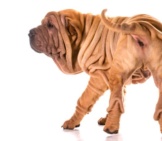The Chinese shar-pei is a unique creature. Their compact size and wrinkled skin make them equally adorable and ridiculous. With a laid back personality that can turn extremely bossy at the drop of a hat, it is no wonder that these dogs are not the best for first time dog owners. Read on to learn more about the Chinese shar-pei.
Description of the Chinese Shar-pei
If you have ever seen a shar-pei, you will never forget them. Medium-sized dogs, they have a perpetually pudgy air about them because of their excess skin. As puppies, wrinkles hang off the shar-pei in layers and folds. As they age, these lessen, but they still give the dogs a distinctive look.
Surprisingly, these dogs were bred for peasants in rural China. They were meant to be versatile hunters and herders. While it’s been a long time since they were used as working dogs, a certain grit is still evident in their personalities today.
The Chinese shar-pei has a short coat, which can take on a range of colors. However, they are best known for a light apricot hue.
The hair can be of various lengths, but all are quite coarse. A short, coarse coat can be irritating to the skin for some individuals, and many struggle with skin allergies. The shortest coat type is most common, but they also come in the brush and bear coat types. The brush coat is slightly longer, while the bear coat is downright shaggy.
Life Expectancy and Size
As interesting as they are, these dogs have some serious health issues.
Healthy dogs can live from 8 to 12 years. However, problems like kidney failure can drastically shorten a shar-pei’s life.
These are medium-sized dogs, ranging from 18 to 20 inches tall at the shoulder. Being quite stout, they can weigh between 45 and 60 pounds.
Protective Ability
This breed is known for its tenacity. Some shar-peis have an aggressive tendency, and may lash out at intruders or other dogs. It is important to take socialization seriously, so that this protective ability is not directed at undeserving targets.
In general, they tend to be more aggressive with other animals than humans. However, the shar-pei is very loyal to his family, and may indeed take it upon himself to protect them if necessary.
Training
This breed can be difficult to train, especially if the owner does not appropriately reward them for good choices. Many shar-peis are less food motivated than other breeds, so finding other ways to reward them for good behavior is important. Praise, petting, extra-tasty treats, or even access to sniffing are helpful tools to have in your arsenal.
The Chinese shar-pei can be quite stubborn. It is best to begin rewards-based training from an early age, before these dogs begin to display problematic behavior. They can bond quite strongly, and will learn best from an owner that they trust and love.
These dogs are also known for their cleverness. They may come up with new and unique ways to cause trouble. Consistency is key.
Energy Level
The shar-pei’s energy level is one of the most appealing aspects of the breed. Bred for their versatility, they can be athletic, but also do not mind lazing around.
These dogs are generally up for anything. Of course, they need regular light exercise to remain healthy. However, beyond that, they tend to be adaptable. They do not mind joining active owners for outings or remaining home with the family.
Due to their short snouts, shar-peis do not do well with intense exercise.
What Living with a Chinese Shar-pei is Like
This breed is not a good choice for a novice dog owner.
The shar-pei can be difficult to train. It is important to devote enough time to obedience and socialization when these dogs are young. Otherwise, it is easy for them to turn into adults that ignore direction and do what they please.
They tend to be suspicious of strangers, and may become downright aggressive if not socialized correctly. These dogs might not be the best choice for households with other pets, especially cats. They are also known to chase livestock, probably a residual instinct from their days of hunting in China.
For families with children, they are not the most popular choice. Still, many individuals handle youngsters just fine. Socialization is key.
However, the shar-pei can be a fun companion for a committed owner. They are very easy going and calm. When they live with an owner that they love and respect, they can fit in as a member of the family. Of course, they are also extremely cute!
A major downside to owning a shar-pei is an expensive price tag. They are not cheap to purchase, and are difficult to find in rescues, and often require expensive medical care to stay healthy.
Care of the Chinese Shar-pei
The Chinese shar-pei requires some extra love and care to flourish. As lovable as they are, they can be difficult to train, socialize, and keep healthy.
Environmental Needs
These dogs are versatile, and can exist in a variety of climates. However, they do not handle extremes well. Their short coats will not keep them warm in freezing environments, so extra care must be taken. Because of their extra skin and oddly shaped noses, breathing can be difficult. This can become a problem in very hot environments.
Exercise Needs
As a baseline, the Chinese shar-pei should receive daily walks. This will help your pup stay fit, and avoid the diseases associated with obesity.
Beyond that, the shar-pei’s exercise regime can vary. Many enjoy participating in activities with their owners, like hikes and jogs. They do not mind exercise, but also do not crave it.
These dogs are susceptible to hip problems later in life. Maintaining their fitness can help this, but overdoing exercise can also exacerbate the problem.
Shedding and Grooming
Caring for the shar-pei’s coat is low maintenance. They do not shed on a regular basis, but have periods of the year where it may be extremely heavy.
Loose hair and dirt can be removed with a grooming mitt. Bathing is not often necessary. In fact, excessive bathing can irritate their sensitive skin. Ensure that the dogs dry properly, as the folds in their skin can harbor bacteria that flourish in a warm, moist environments.
These dogs are also prone to ear infections. Wash regularly with solution recommended by your veterinarian.
Ideal Home Environment
This breed is ideal for the experienced dog owner. They require a steady hand in training, and it is essential to dedicate enough time to obedience and socialization.
However, with proper training, the shar-pei is perfect for an owner that wants a loyal dog. They are calm and independent, but also able to bond strongly. These dogs can handle quite a bit of exercise or very little. They can adapt to athletes and homebodies.
This dog should not be kept in areas with livestock. Homes with children or other pets may not always be the best option for the shar-pei. However, with proper socialization, many of these dogs have made perfectly lovely family pets.
Be aware that owning a shar-pei is not cheap. Their pedigree has an expensive price tag, and a myriad of health problems means that the expenses may continue for the rest of their lives.
Health Concerns
This dog has many specific health concerns. Bred to be overly wrinkled with a short nose, they are cuter than they are practical.
Their skin is often sensitive, and prone to bacterial infection. Eye and ear infections are also not uncommon.
Because of the shape of their noses, many have trouble breathing. This may cause noisy breathing or even fainting. Joint problems are also an issue, especially in the hip and elbow.
Familial Shar-pei Fever can cause kidney disease or failure. This affects about 20% of all Chinese shar-pei.
Behavior Problems
This breed can be aggressive. This is particularly true if they are allowed to access livestock. They may also chase cats.
They are also known to be standoffish or aggressive with other dogs, and sometimes even people. They are naturally suspicious of strangers, so they need to be socialized early on to avoid any future problems.
























![Red Angus Closeup of a beautiful Red Angus cowPhoto by: U.S. Department of Agriculture [pubic domain]https://creativecommons.org/licenses/by/2.0/](https://animals.net/wp-content/uploads/2020/03/Red-Angus-4-100x75.jpg)

